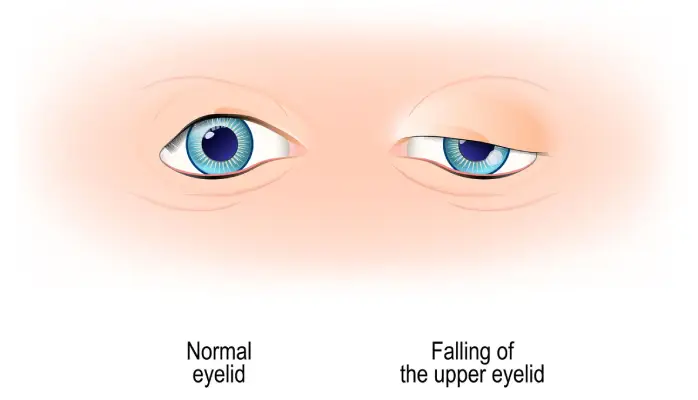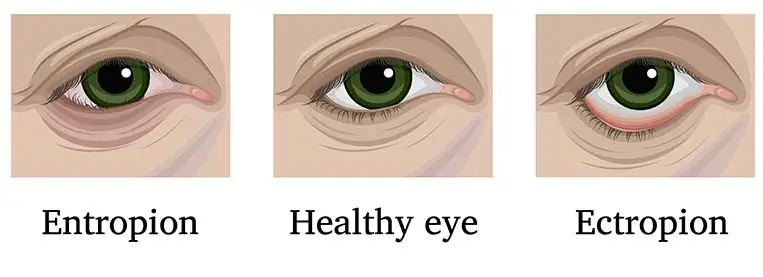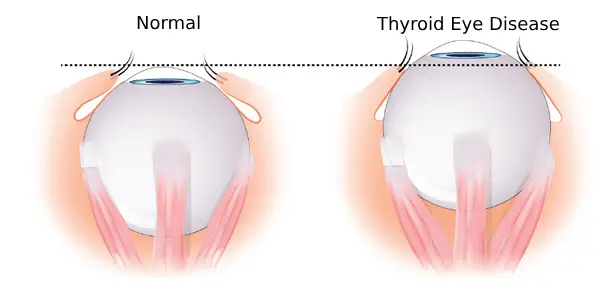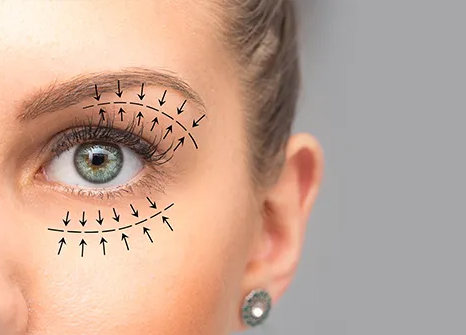Excess Upper Eyelid Skin -Dermatochalasis
Excess upper eyelid skin, also known as dermatochalasis, is a condition characterized by an abundance of skin in the upper or lower eyelid, leading to issues such as hooded or droopy eyelids.
Causes of Dermatochalasis:
- Excess eyelid skin can be attributed to various factors such as:
- Aging,
- Genetics,
- Prolonged sun exposure,
- Smoking, and certain medical conditions.
- These factors can lead to the loss of skin elasticity and the accumulation of fat deposits in the upper eyelids.
Symptoms
- Excess upper eyelid skin can manifest in different ways, including:
- Vision obstruction,
- Aesthetic concerns such as droopy or puffy eyelids, and
- A perpetually tired appearance.
- These symptoms can impact both the function and appearance of the eyes, affecting one's overall facial expression and confidence.
Treatment
- When dealing with excess upper eyelid skin, there are several treatment options available.
- Surgical intervention, such as blepharoplasty, involves the removal of excess skin and fat, along with the tightening of underlying muscles to achieve a more rejuvenated look.
Understanding the Blepharoplasty Procedure:
- Blepharoplasty is a surgical procedure designed to enhance the appearance of the eyelids by addressing excess skin and fat.
- During the procedure, a low skin incision is made for upper eyelid fat removal, followed by the removal of excess fat and the placement of skin sutures to achieve the desired outcome.
- The recovery period after blepharoplasty may involve temporary bruising and swelling, which typically subside within 1-2 weeks post-surgery.
Recovery Period Care After Blepharoplasty Surgery:
Immediate Post-Operative Care:
- Ice Packs: Apply ice packs on the eyes for 10 minutes every hour on the night after surgery and 4 to 5 times throughout the day the following day.
- Eye Drops: Use prescribed eye drops or ointments to keep the eyes lubricated.
- Head Elevation: Sleep with the head raised higher than the chest for a few days.
- Cool Compresses: Apply cool compresses to reduce swelling.
- Sunglasses: Wear dark sunglasses to protect the eyelids from sun and wind exposure.
- Pain Management: Use acetaminophen (Tylenol) as directed to control pain.
Activities to Avoid:
- Strenuous Activities: Avoid heavy lifting, swimming, jogging, or aerobics for at least a week.
- Smoking: Refrain from smoking to promote healing.
- Eye Rubbing: Avoid rubbing the eyes to prevent irritation.
- Contact Lenses: Do not wear contact lenses for about two weeks post-surgery.
- Medications: Avoid aspirin and other drugs that can increase bleeding unless instructed otherwise.
Follow-Up Care:
- Stitches Removal: Visit the healthcare provider's office to have stitches removed if necessary.
- Monitoring: Seek medical attention immediately if experiencing shortness of breath, chest pain, unusual heart rate, severe eye pain, bleeding, or vision problems.
Complication Management:
- Infection and Bleeding: Monitor for signs of infection and bleeding, and seek prompt medical attention if observed.
- Dry, Irritated Eyes: Use prescribed eye drops to relieve dryness and keep the eyes hydrated.
- Difficulty Closing Eyes: Report any issues with eye closure or other eyelid problems to the healthcare provider.
- Noticeable Scarring: Follow post-operative care instructions to minimize scarring and encourage less visible scars.
- Injury to Eye Muscles: Report any concerns about eye muscle function to the healthcare provider for evaluation.
- Skin Sensitivity: Protect the delicate eyelid skin from sun exposure to aid in the healing process.
By following these guidelines for the recovery period and being vigilant about potential complications, patients can enhance their healing process and achieve optimal outcomes after blepharoplasty surgery.
Eyelid Ptosis

Causes:
- Muscle Weakness: Weakness in the muscle responsible for lifting the eyelid can lead to ptosis.
- Nerve Damage: Damage to the nerves controlling the eyelid muscles can result in drooping eyelids.
- Aging: As we age, the muscles around the eyes can weaken, causing ptosis.
- Congenital Factors: Some individuals may be born with a predisposition to eyelid ptosis.
Symptoms:
- Drooping Upper Eyelid: The most noticeable symptom is a drooping upper eyelid that may obstruct vision.
- Vision Obstruction: Ptosis can interfere with vision by partially covering the eye.
- Aged or Tired Appearance: Drooping eyelids can give a person a tired or aged look.
Treatment Options:
- Surgery to Tighten or Reattach the Levator Muscle: This surgical procedure aims to lift and reposition the drooping eyelid.
- Frontalis Sling Surgery for Severe Cases: In more severe instances of ptosis, a frontalis sling surgery may be recommended.
- Botox Injections for Temporary Improvement: Botox injections can provide temporary relief by lifting the eyelid.
Eyelid Ptosis Surgery:
- Eyelid ptosis surgery is a procedure designed to raise drooping eyelids back to their correct position, improving both function and appearance.
Procedure:
- This surgery can be performed alone or in combination with other eyelid surgeries to address cosmetic concerns such as wrinkles and overall aesthetic enhancement.
Candidates
- Patients who experience drooping eyelids due to medical conditions, trauma, or congenital issues are potential candidates for eyelid ptosis surgery.
- It is essential to consult with a qualified healthcare provider to determine the most suitable treatment plan for individual needs and goals.
Entropion

Entropion is a condition where the eyelid turns inward, causing the lashes to rub against the eye. This can lead to irritation, redness, and potentially damage to the cornea if left untreated.
Causes:
- Aging: As we age, the muscles around the eye may weaken, leading to eyelid malposition.
- Facial nerve palsy (e.g., Bell's Palsy): Nerve damage can affect the muscles that control eyelid movement.
- Scarring from injury or surgery: Scar tissue can distort the normal position of the eyelid.
Symptoms:
- Inward-turning eyelid: The edge of the eyelid turns inward towards the eye.
- Eye irritation and redness: Constant rubbing of lashes against the eye can cause discomfort and redness.
- Corneal damage if left untreated: Continuous irritation from the eyelashes can lead to corneal abrasions or ulcers.
Treatment Options:
If you have entropion, your doctor may recommend:
- Surgical correction: This involves restoring the eyelid's normal position through surgery.
- Supportive tissue repair: Strengthening the tissues around the eyelid to help maintain proper alignment.
Entropion Surgery
Entropion surgery aims to correct the abnormal inward rotation of the eyelid to alleviate symptoms and prevent complications.
Procedure: During surgery, techniques such as tightening the lower eyelid through a lateral tarsal strip procedure or lateral canthal tendon plication may be used to reposition the eyelid.
Recovery:
- After surgery, it's important to follow your doctor's instructions for care. Minor issues like slight dehiscence (separation of wound edges) can usually be managed with antibiotics. However, complete dehiscence may require prompt repair to prevent any complications.
- Remember, early intervention and proper treatment can help improve your symptoms and prevent further damage to your eye.
If you suspect you have entropion, consult with an ophthalmologist for a thorough evaluation and personalized treatment plan.
Entropion Surgery
Ectropion is a condition where the lower eyelid turns outward, causing symptoms like watery eyes, irritation, and exposure of the cornea. It is often associated with aging, facial nerve weakness, and skin laxity due to sun damage.
What Causes Ectropion?
- Aging: As we age, the tissues around the eyes can weaken and lose elasticity, leading to eyelid malposition.
- Facial Nerve Weakness: Damage or weakness in the facial nerve can affect the muscles that control eyelid movement.
- Skin Laxity from Sun Damage: Prolonged sun exposure can accelerate skin aging and contribute to the laxity of eyelid skin.
What are the Symptoms of Ectropion?
- Outward-Turning Eyelid: The lower eyelid may sag or droop away from the eye.
- Watery Eyes: Excessive tearing can occur due to poor drainage caused by the malpositioned eyelid.
- Corneal Exposure and Irritation: The cornea, the clear front surface of the eye, may become exposed and irritated due to inadequate protection from the eyelid.
How is Ectropion Treated?
- Ectropion is typically treated through surgical repair to reposition the eyelid and tighten supportive tissues and muscles around the eye. The goal of surgery is to correct the abnormal outward turning of the lower eyelid.
- During ectropion surgery, the lower eyelid is tightened through a procedure that involves a lateral canthal tendon plication as part of lower lid blepharoplasty. This helps restore proper alignment and function of the eyelid.
What Can I Expect During Recovery?
- After ectropion surgery, complications like dehiscence (wound separation) are less common and can usually be managed supportively.
- It's important to follow post-operative care instructions provided by your healthcare provider for optimal healing and outcomes.
Tear Duct Issues/ Blockage of Tear Duct
When tear ducts become blocked or narrowed, it can lead to various symptoms and discomfort. Here's a closer look at what causes blockage of tear ducts, its symptoms, and treatment options:
Causes of Blockage of Tear Duct:
- Blockage or narrowing of tear ducts
- Infections or inflammations
Symptoms of Tear Duct Issues:
- Excessive tearing or dry eyes
Treatment Options for Blockage of Tear Duct:
- Dilation of tear ducts
- Stenting or surgical repair
What is Blockage of Tear Duct Surgery?
Blockage of tear duct surgery involves a procedure known as dacryocystorhinostomy (DCR) to create a new drainage pathway for tears. Let's delve into more details:
What Does Blockage of Tear Duct Surgery Involve?
During the surgery for blocked tear ducts, a new drainage pathway is established to alleviate the blockage and improve tear drainage. This can be done in two ways:
- External Approach: The surgery is performed externally, typically around the corner of the eye.
- Endoscopic Approach: Alternatively, the procedure can be done endoscopically through the nasal passage, which is less invasive.
How Does Surgery Help Unblock Tear Ducts?
By creating a new pathway for tears to drain properly, the surgery aims to relieve symptoms like excessive tearing or dry eyes caused by the blockage of tear ducts. It allows tears to flow freely, reducing discomfort and improving eye health.
What to Expect After Blockage of Tear Duct Surgery?
- After the surgery, patients may experience some mild discomfort, swelling, or bruising, which is normal and can be managed with proper care and medication. It's essential to follow post-operative instructions provided by your healthcare provider for a smooth recovery.
- Blockage of tear ducts can be effectively addressed through surgical intervention like dacryocystorhinostomy, offering relief from symptoms and improving tear drainage. Understanding the causes, symptoms, and treatment options can help patients make informed decisions about their eye health.
Thyroid Eye Disease

Thyroid Eye Disease, also known as Graves ophthalmopathy, is a condition where an autoimmune disorder affects both the thyroid gland and the muscles around the eyes. This can lead to various symptoms and complications that affect the eyes and vision.
What Causes Thyroid Eye Disease?
- Thyroid Eye Disease is primarily caused by an autoimmune disorder that affects the thyroid gland and the muscles around the eyes.
- This condition is often associated with Graves' disease, which is an autoimmune disorder that affects the thyroid gland.
What are the Symptoms of Thyroid Eye Disease?
The symptoms of Thyroid Eye Disease can vary but commonly include:
- Bulging eyes (proptosis)
- Double vision
- Eye pain
- Redness
- Swelling
- Difficulty closing the eyes completely.
How is Thyroid Eye Disease Treated?
Treatment for Thyroid Eye Disease aims to manage symptoms and improve the overall condition. Medications are often prescribed to help control thyroid hormone levels and manage symptoms. In severe cases, where symptoms are affecting vision or causing significant discomfort, orbital decompression surgery may be recommended to alleviate pressure on the eyes and improve their function.
What are the Treatment Options for Thyroid Eye Disease?
- Medications: Doctors may prescribe medications to regulate thyroid hormone levels and manage symptoms such as eye inflammation and discomfort.
- Orbital Decompression Surgery: In severe cases where symptoms are impacting vision or causing significant eye problems, orbital decompression surgery may be recommended. This surgical procedure helps to relieve pressure on the eyes by creating more space within the eye socket.
How Can I Manage Thyroid Eye Disease?
- If you have been diagnosed with Thyroid Eye Disease, it is important to work closely with your healthcare provider to develop a treatment plan that suits your specific needs.
- Additionally, maintaining good overall health, managing stress, and following a healthy lifestyle can help support your treatment and improve your overall well-being.
- Regular follow-up appointments with your healthcare team are essential to monitor your condition and adjust treatment as needed.
Common FAQs for Oculoplastic Surgery
Q: Is oculoplastic surgery safe?
A: Oculoplastic surgery is generally safe when performed by qualified professionals.
Q: How long is the recovery period for blepharoplasty?
A: Recovery varies but expect bruising and swelling for 1-2 weeks post-surgery.
Q: Can entropion surgery be done as an outpatient procedure?
A: Yes, entropion surgery is typically performed as an outpatient procedure.
Q: What are the risks associated with ectropion surgery?
A: Risks include minor dehiscence, which can usually be managed supportively.
Q: How effective is eyelid ptosis surgery in improving vision?
A: Eyelid ptosis surgery can significantly improve vision by raising drooping eyelids to the correct position.
For a detailed evaluation and personalized treatment plan, consult with our expert oculoplastic surgeon at Smart Vision Eye Centre in Andheri.





